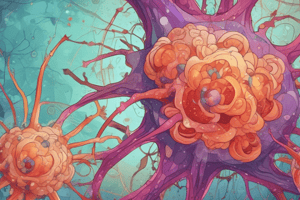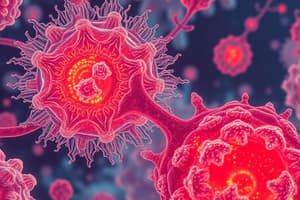Podcast
Questions and Answers
Main cells involved in inflammation include which of the following?
Main cells involved in inflammation include which of the following?
- Neutrophils
- Monocytes (macrophages)
- Lymphocytes
- All of the above (correct)
In acute inflammation of the lung (acute bronchopneumonia), eosinophils fill the alveolar spaces and blood vessels are congested.
In acute inflammation of the lung (acute bronchopneumonia), eosinophils fill the alveolar spaces and blood vessels are congested.
False (B)
What is the typical granuloma resulting from?
What is the typical granuloma resulting from?
Infection with Mycobacterium tuberculosis
Swollen, congested and haemorrhagic appendix covered by thick creamy _________ exudate on the serosa.
Swollen, congested and haemorrhagic appendix covered by thick creamy _________ exudate on the serosa.
What are some histologic features of chronic inflammation in the lung?
What are some histologic features of chronic inflammation in the lung?
Which of the following are main cells involved in inflammation?
Which of the following are main cells involved in inflammation?
What is a typical granuloma resulting from infection with Mycobacterium tuberculosis showing?
What is a typical granuloma resulting from infection with Mycobacterium tuberculosis showing?
Describe the gross description of the appendix in appendicitis.
Describe the gross description of the appendix in appendicitis.
Flashcards
Inflammation
Inflammation
A biological response to harmful stimuli, causing immune activation.
Neutrophils
Neutrophils
White blood cells that respond quickly to sites of infection or injury.
Monocytes
Monocytes
Immune cells that differentiate into macrophages during inflammation.
Macrophages
Macrophages
Signup and view all the flashcards
Lymphocytes
Lymphocytes
Signup and view all the flashcards
Acute Inflammation
Acute Inflammation
Signup and view all the flashcards
Chronic Inflammation
Chronic Inflammation
Signup and view all the flashcards
Appendicitis
Appendicitis
Signup and view all the flashcards
Microscopy in inflammation
Microscopy in inflammation
Signup and view all the flashcards
Acute vs Chronic
Acute vs Chronic
Signup and view all the flashcards
Acute vs Chronic Inflammation
Acute vs Chronic Inflammation
Signup and view all the flashcards
Role of Neutrophils
Role of Neutrophils
Signup and view all the flashcards
Monocyte maturation
Monocyte maturation
Signup and view all the flashcards
Study Notes
Inflammation Overview
- Inflammation is a complex biological response to harmful stimuli, including pathogens, damaged cells, and irritants.
- It's characterized by various cellular and vascular reactions aimed at eliminating the harmful agent and initiating tissue repair.
Main Cells Involved in Inflammation
- Neutrophils: First responders in the inflammatory process, crucial in acute inflammation. They are phagocytic cells and engulf pathogens.
- Monocytes (macrophages): Phagocytic cells, crucial for both acute and chronic inflammation. They play a role in antigen presentation and initiating tissue repair.
- Lymphocytes: Crucial in chronic inflammation. These include B and T cells which play a key role in the adaptive immune response.
Acute Inflammation
- Characterized by a rapid response.
- Key features include redness, swelling, heat, pain, and loss of function.
- Microscopic findings often show neutrophils dominating the inflammatory infiltrate.
Chronic Inflammation
- A sustained inflammatory response, often lasting for prolonged periods.
- Characterized by chronic inflammation.
- Involves lymphocytes, macrophages, and other immune cells.
- Microscopic examination reveals a diverse cellular infiltrate with lymphocytes, macrophages as well as fibrosis (scar tissue formation).
Chronic Granuloma
- A distinctive form of chronic inflammation, forming a granuloma.
- Features a granuloma, a structure characterised by a central area of necrosis, activated macrophages, giant cells, and a surrounding accumulation of lymphocytes.
- Often associated with infections, such as tuberculosis. Mycobacterium tuberculosis can cause granulomas.
Acute vs Chronic Inflammation
- Acute inflammation is a rapid response to injury, and generally characterized by neutrophils, while chronic inflammation is a prolonged response often associated with macrophages and lymphocytes. Chronic inflammation can lead to tissue damage and fibrosis. Acute inflammation is a temporary response, whereas chronic inflammation persists longer.
Appendicitis (Acute Inflammation)
- Appendicitis describes the inflammation of the appendix, a small, finger-like pouch attached to the large intestine.
- Gross features of acute appendicitis include a swollen, congested and hemorrhagic appendix often containing pus, covered by fibrinopurulent exudate.
- Microscopic features include transmural, acute inflammation (infiltration of neutrophils throughout the appendix wall), mucosal ulceration, and serosal exudates. The lumen may contain pus.
Studying That Suits You
Use AI to generate personalized quizzes and flashcards to suit your learning preferences.




